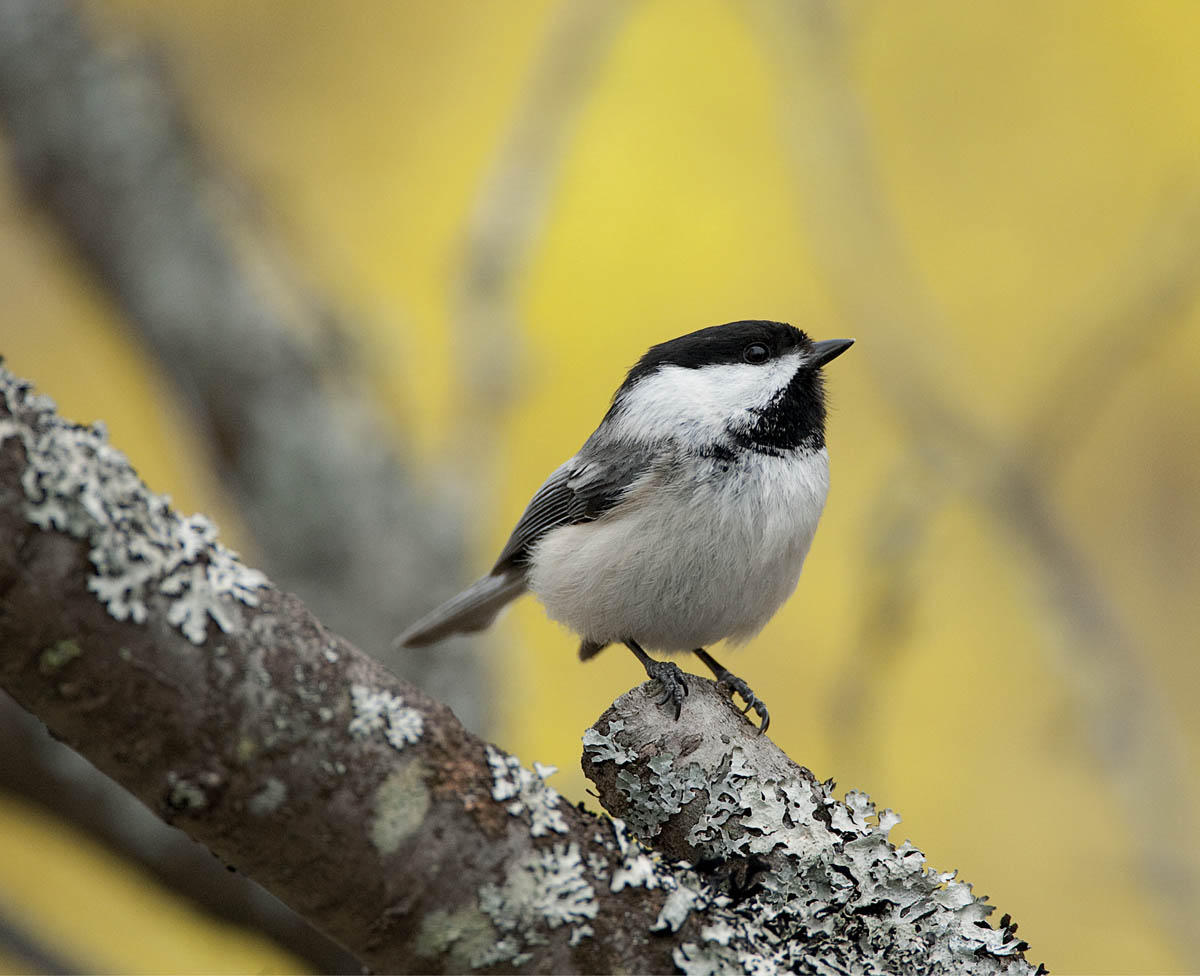
Black-capped Chickadee
Beginning on the winter solstice, with the severest temperatures still ahead, days start growing longer and a handful of our tiniest, toughest winter residents are already preparing to breed. The frigid air is filled with their songs — the ethereal hey, sweetie! of chickadees and the piercing peter, peter, peter of the Tufted Titmouse.

Black-capped Chickadee
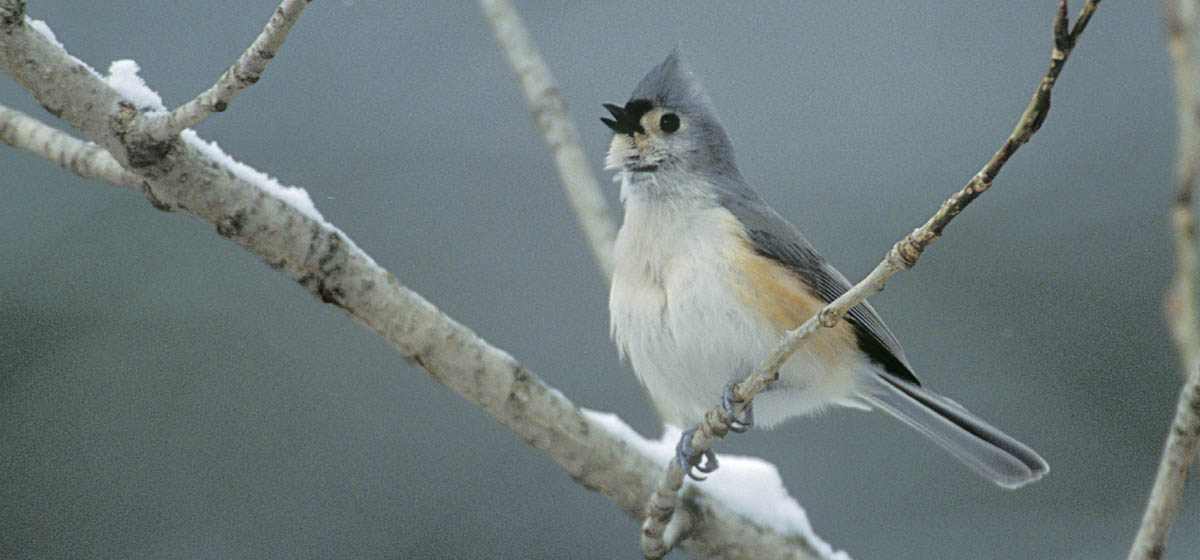
Even during the coldest weather, titmice and chickadees often sing. Tufted Titmice whistle a song that sounds like peter, peter, peter.
Black-capped and Carolina Chickadees spend the winter in sociable flocks composed of pairs of adults that bred the previous year, single adults that have lost a mate, and young birds that hatched the previous summer. Usually, those young birds are not the offspring of any of the adults and do not have siblings in that flock. At the previous summer’s end, each young chickadee left its parents and siblings to join a flock made up of strangers. This may help ensure that as chickadees choose mates over the winter, young birds will not end up pairing with a close relative.
Even though chickadees form pairs in winter, most of their flock activities focus on finding food and shelter and avoiding predators. But during free moments even in January, males occasionally sing their clear, whistled songs.
Males and females each have a position within their flock’s social hierarchy. The frequency and strength of songs confirm each male’s place on the social ladder. The highest-ranking male and highest-ranking female end up pairing, second-ranked male and second ranked female, and so on.
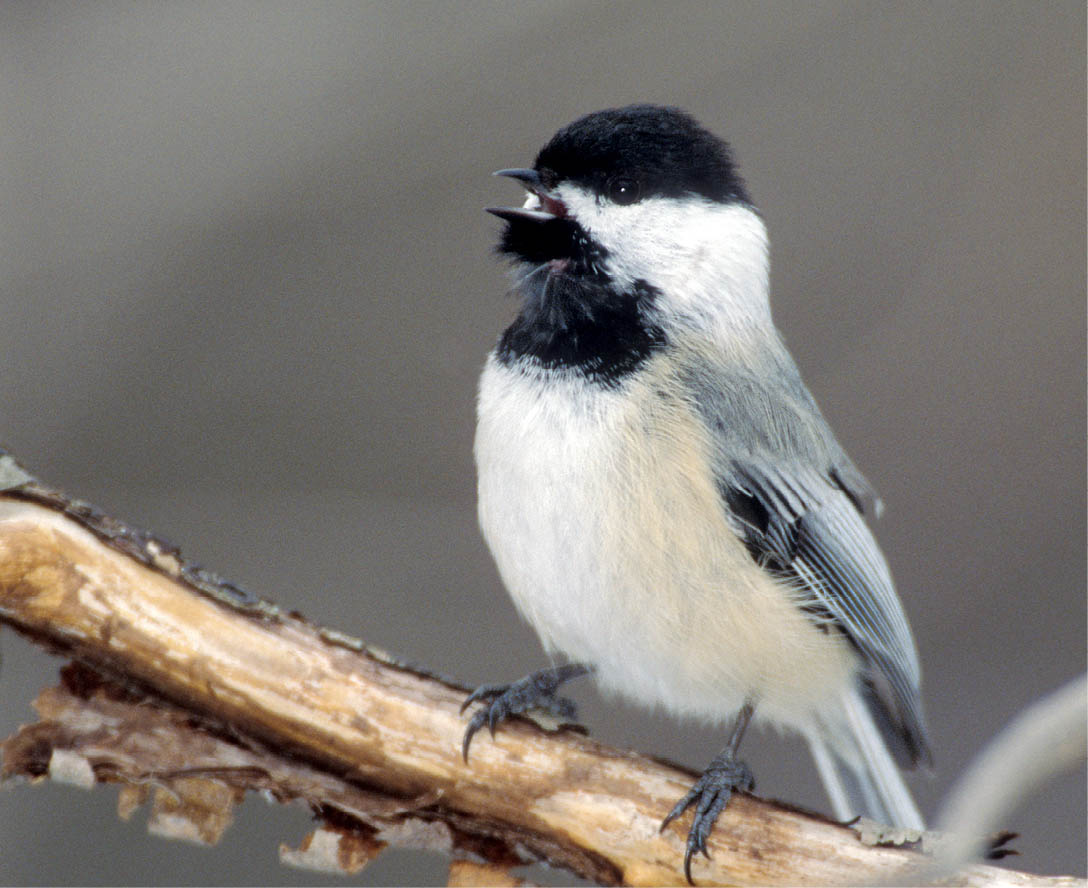
Black-capped Chickadees sing a clear, whistled hey, sweetie!
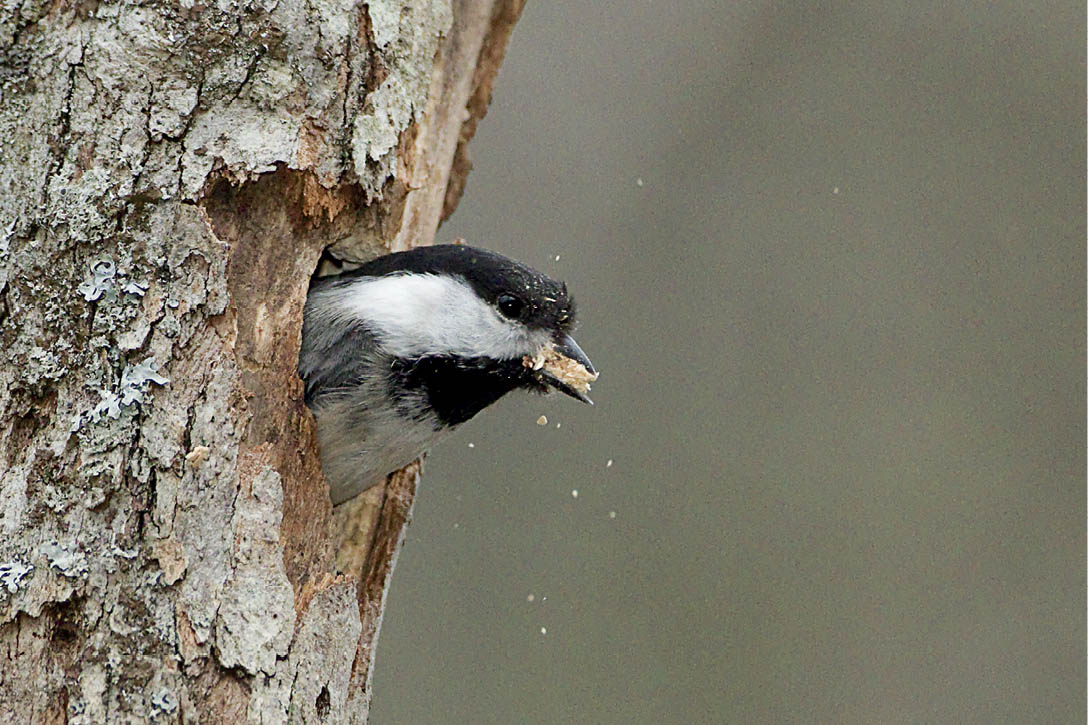
Despite their tiny beaks, chickadees can dig out their own nest cavities in soft, rotten wood, especially in aspen or birch trees. They sometimes nest in birdhouses, especially when we stuff them with wood shavings or sawdust for the chickadees to clear out. Chickadees can nest at just about any height, from near the ground to high up in a tall tree.
As winter progresses into spring, those pair bonds strengthen. If a paired Black-capped Chickadee dies after other pair bonds in the hierarchy are established, its mate will accept a young, low-ranking chickadee that gets to jump up the social ladder to assume the lost partner’s place.
Tufted Titmice are close relatives of chickadees; their range overlaps Carolina Chickadees more than it does black-caps. Like chickadees, they begin singing in winter, their whistled song often interpreted as peter, peter, peter. Unlike chickadees, Tufted Titmice usually remain on or near their breeding territory all winter, spending the season in small family units of one adult pair and, often, one of their offspring from the previous summer. Come spring, most young titmice go off and find a mate, but some occasionally remain with their parents, helping them raise a new batch of young. This behavior is not found in any other American chickadee or titmouse.
Territorial year round, titmice don’t need to establish new territories come spring. Chickadees do: on fine days, pairs may separate from their flock for a while to claim and start defending a nesting territory. During bad weather and when searching for food, they gravitate back to their flock, which won’t completely break up until late April or May.
Throughout the year, titmice and chickadees sleep in woodpecker holes, natural cavities, bird boxes, and other little crevices. Chickadees often excavate their own cavities in birches or aspens. They also roost in trees with harder wood, taking over a cavity excavated by another bird or created naturally, such as at a rotten knothole. Tufted Titmice are more dependent on already-existing cavities.
Though sociable, chickadees and titmice seem to need more personal space than many songbirds. At feeders, they take turns grabbing a seed and flying off to eat in seclusion rather than feeding side by side like finches. And in their roosting cavities, even on the coldest nights, chickadees rarely share body warmth by huddling. After male nestlings fledge, virtually none will share a cavity with another chickadee again in their lives; females will share cavity space only with their own young while incubating eggs and brooding chicks.
At dawn on February 2, 1996, the official weather station thermometer in Tower, Minnesota, read -60° F (-20° C), the coldest temperature ever recorded in the state. News reporters gathered to report on and celebrate the endurance of an intrepid man who had slept out in a well-insulated snow fort with a camp stove that night.
No one on the scene paid any attention to the many Black-capped Chickadees calling in the background. Those tiny birds, weighing a third of an ounce, had been out all night, too, naked as jaybirds, each sleeping in its own tiny tree cavity. The chickadees didn’t consider their overnight survival a triumph; it was just business as usual. And on this coldest dawn in Minnesota history, these chickadees were not just making the usual chickadee-dee-dee calls — they were also whistling their hey, sweetie! spring song.
As spring advances, already established pairs of chickadees and titmice focus on settling down to raise a family. After a pair finds or excavates a nest cavity, they work together to build the nest, using vegetation for the cup and fur and soft plant fibers for the lining. They find clumps of fur here and there, pulling some off animals, dead or alive. One of the authors watched a Tufted Titmouse pluck fur from a road-killed red squirrel, and another pluck hairs from the tail of a sleeping raccoon.
Building the nest together is one of the activities that help strengthen the bond between mates. If a nearby chickadee male sings more than a particular female’s mate, however, she can’t help but gravitate to him occasionally, so some of her young may have a father different from the male raising them. Fortunately, male chickadees never demand paternity tests.
Despite their tiny size, chickadees and titmice produce more eggs in a single clutch than most songbirds do. A day or so after her nest is ready, the Black-capped Chickadee female starts laying one egg early each morning until she has a clutch of six to eight eggs. Sometimes she produces even more: a nest with nine is fairly common, and one chickadee clutch contained 13 eggs. Titmice weigh significantly more than chickadees but produce similar-sized clutches.
These birds literally put all their eggs in one basket — unless a nest is destroyed early in the process and the pair starts over, this will be their only shot at raising young for the year.
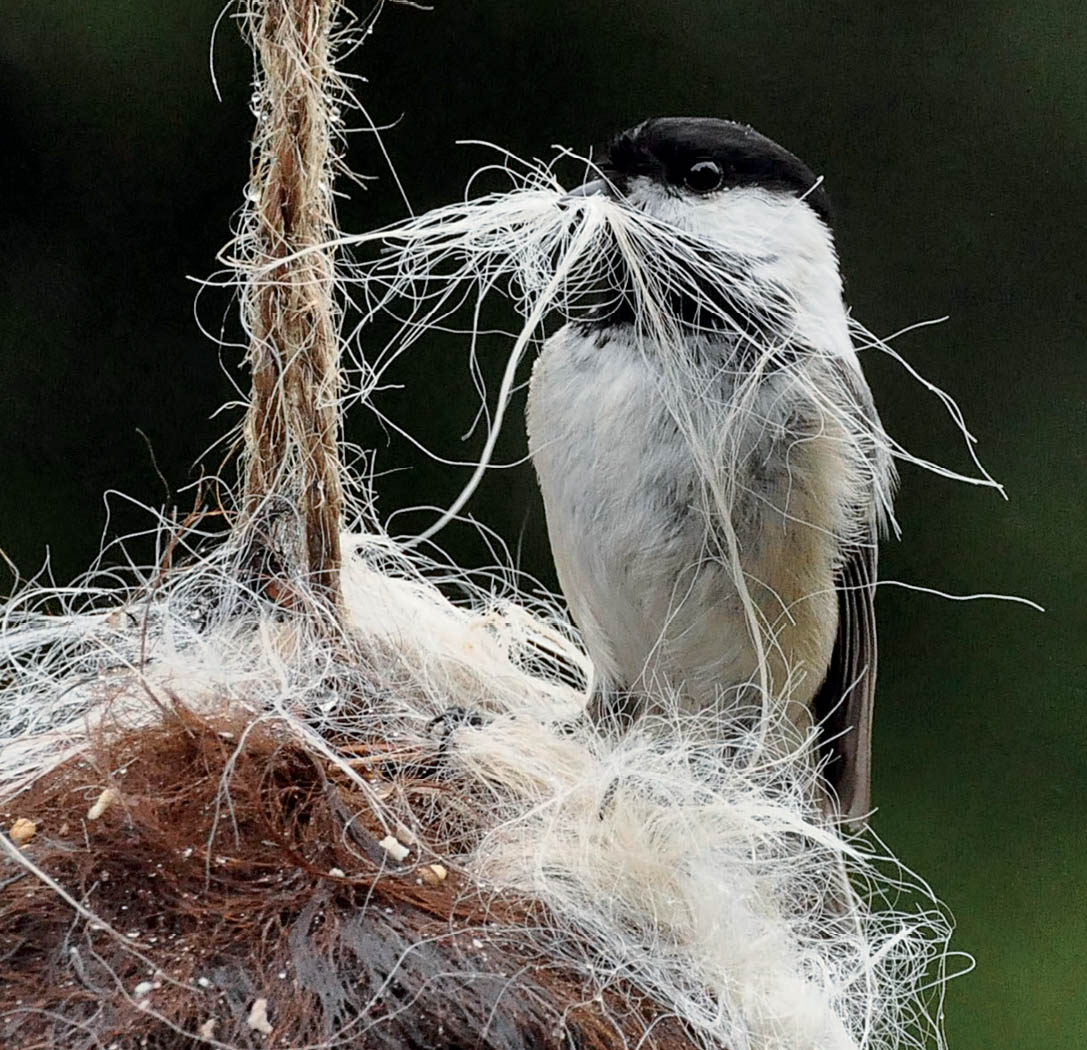
After clearing out a cavity, chickadees build a cup nest from mosses and other fibers, lining it with soft fur they may pick directly off animals or from clumps offered by people. This chickadee is taking a beakful of alpaca fiber from a hanging ball. They also take wads of dog or cat fur people pull off brushes after grooming pets.
Only females incubate the eggs. The female chickadee spends about 75 percent of daylight hours and all night on the job until the eggs hatch in about 13 days. Her mate spends his time searching for food for the two of them; he feeds her while she’s both on and off the nest. For the first few days after the eggs hatch, when the nestlings can’t regulate their body temperature, the male continues bringing food for the entire family while the female broods the nestlings. As the chicks grow in size and hunger, the female starts searching for food, too, and both parents feed them fairly equally by the time they are about a week old. Tufted Titmouse parents occasionally get help from a youngster they raised the previous year.
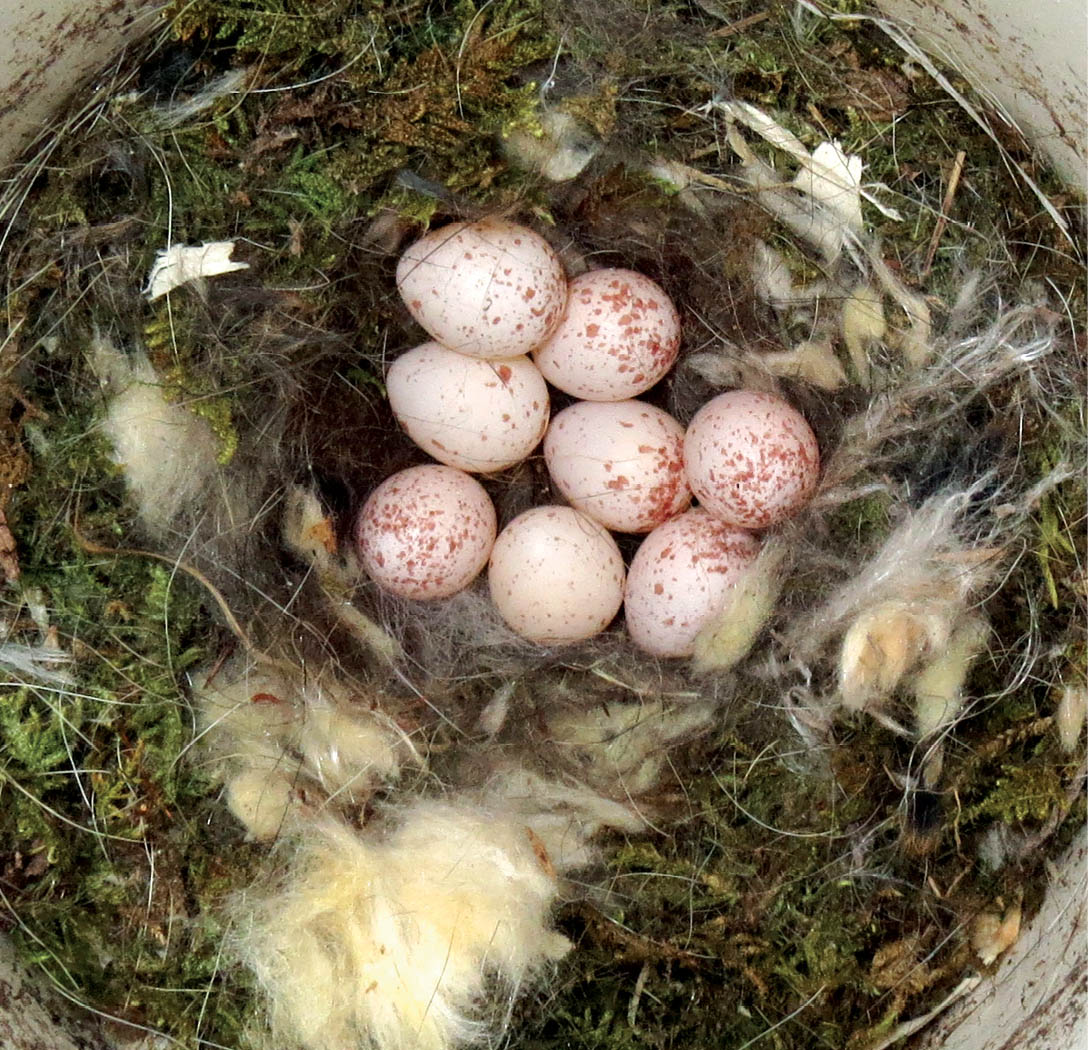
Eight Black-capped Chickadee eggs rest on a bed of moss, animal fur and hair, and wood shavings. To keep the eggs warm and moist while she’s gone, and perhaps to hide them from predators, the mother often covers the eggs with nest material before leaving.
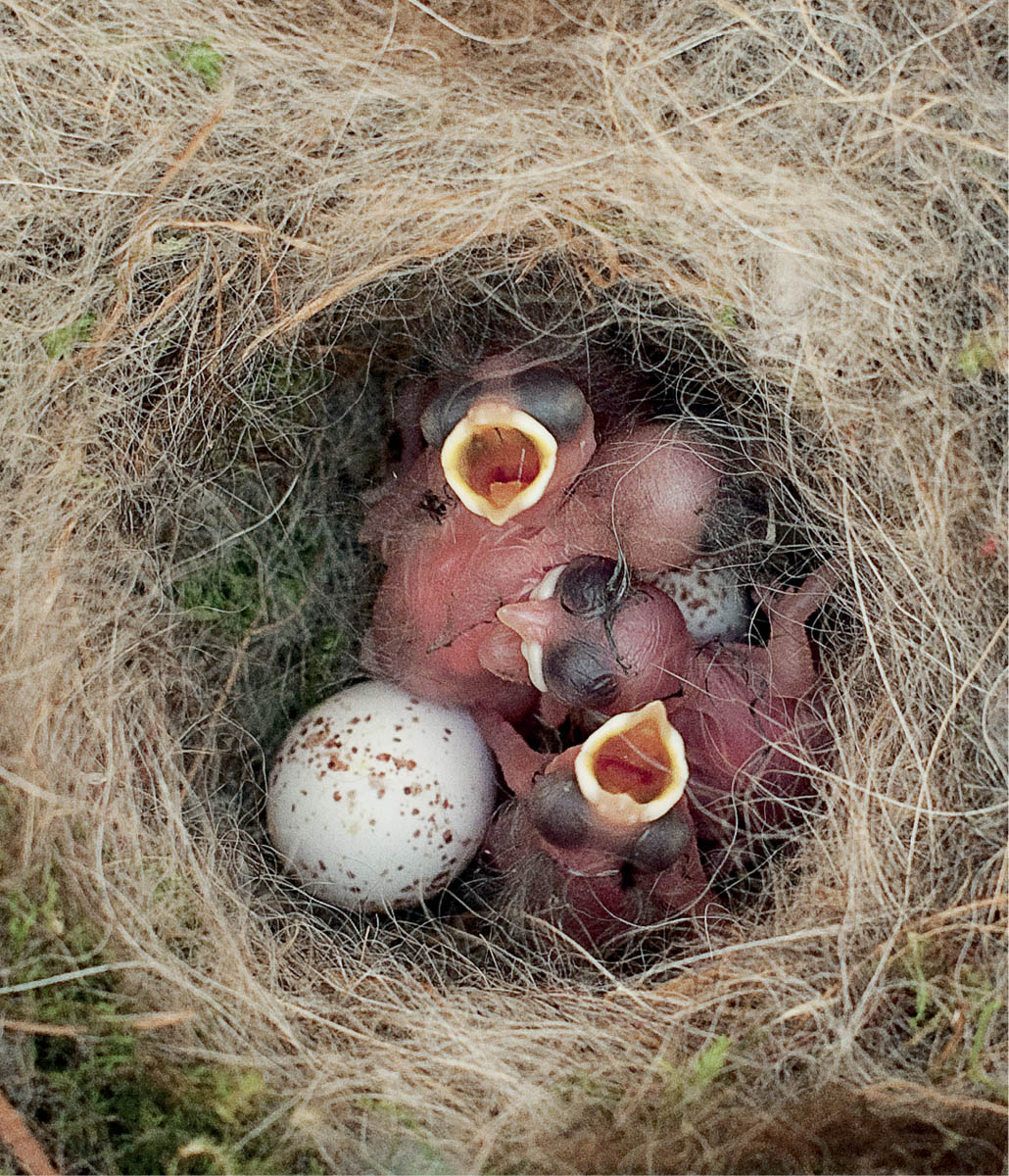
Four tiny Black-capped Chickadees have just hatched; at least two siblings are still inside their eggs. The soft nest materials protect their fragile skin. Even before their eyes open, they pop up at their parents’ arrival. The adults eagerly stuff food into those large, brightly colored mouths.
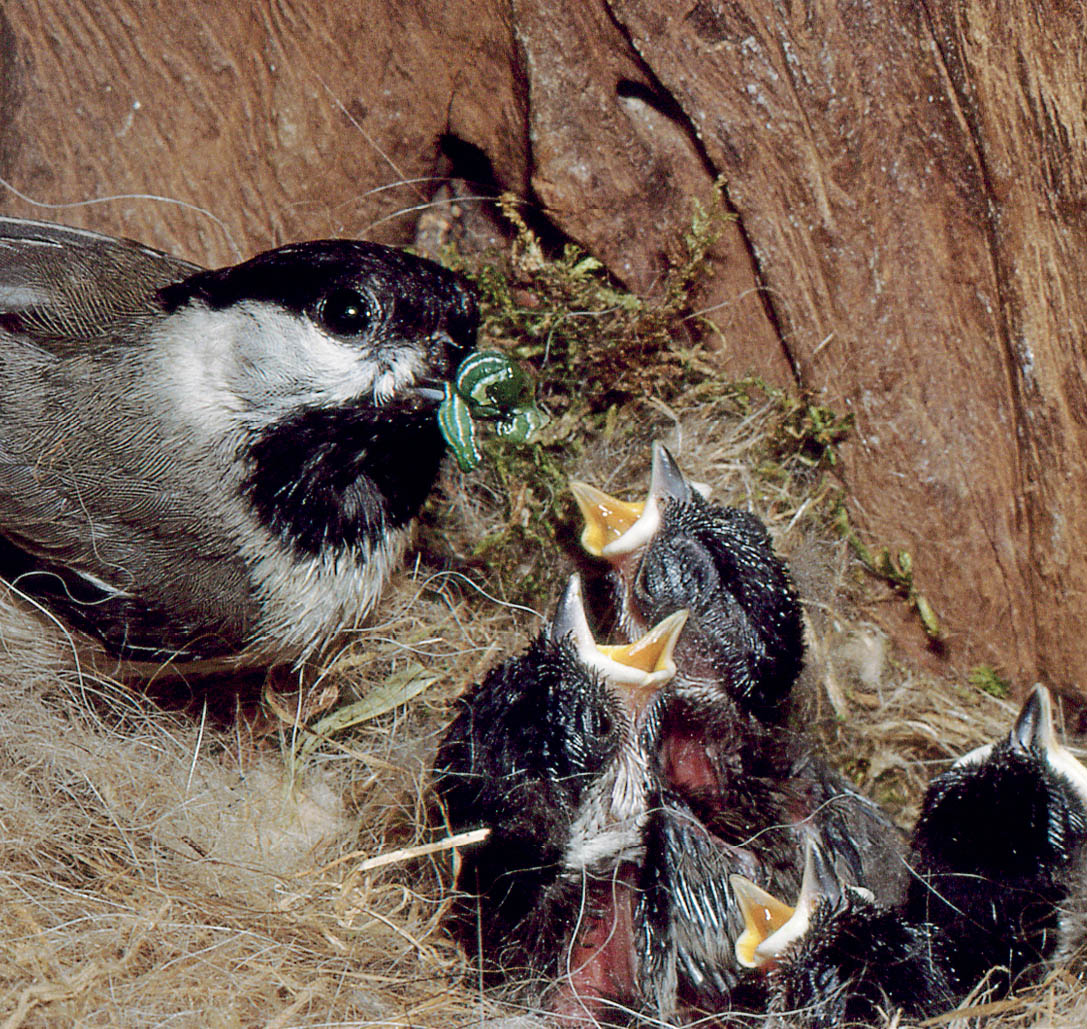
A Carolina Chickadee brings a caterpillar to its 12-day-old nestlings. Their eyes are open and their feathers still encased in sheaths.
Trees and shrubs provide a built-in safety net for nestlings that grown up in open cup nests — lower branches that can catch little songbirds hopping out of the nest before they can fly. Cavities, however, are usually dug into the trunk or other part of the tree with no such safeguards. Unless frightened by an intruder, nestlings in cavities don’t leave the nest until they are more mature and can fly to a safe spot where they can build up their flight muscles.
Chickadee and titmouse fledglings remain dependent on their parents for two to four weeks after leaving the nest. Neither reduced feedings nor parental aggression seem to force the young away — they just suddenly move on. One or two titmice may remain with their parents through their first winter, but it is unpredictable.
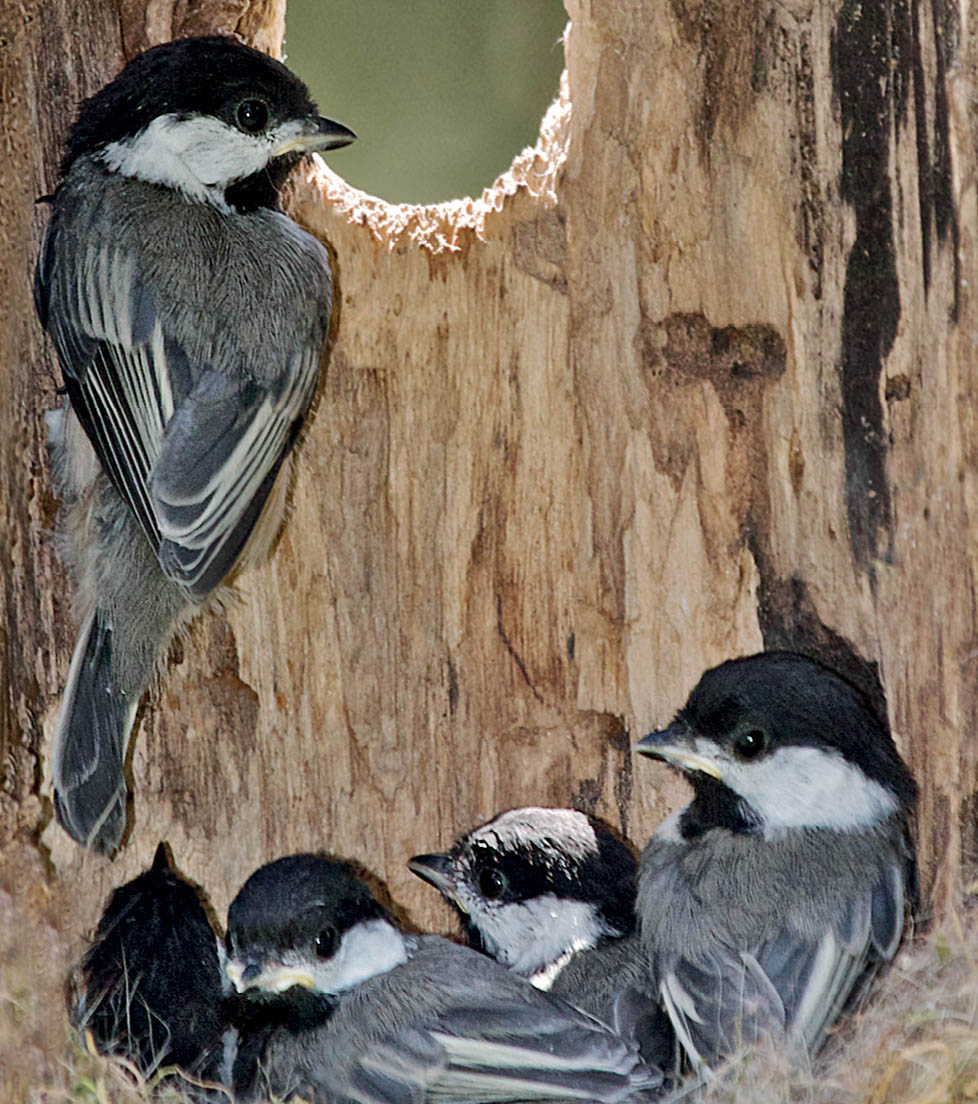
These five Black-capped Chickadee nestlings are almost ready to fledge. If an intruder frightened them from the nest now, they’d usually survive, but the longer they remain in the nest, the stronger their first flights will be and the better their chances of survival. The chickadee at the entrance will most likely be the first one fed next time a parent arrives.
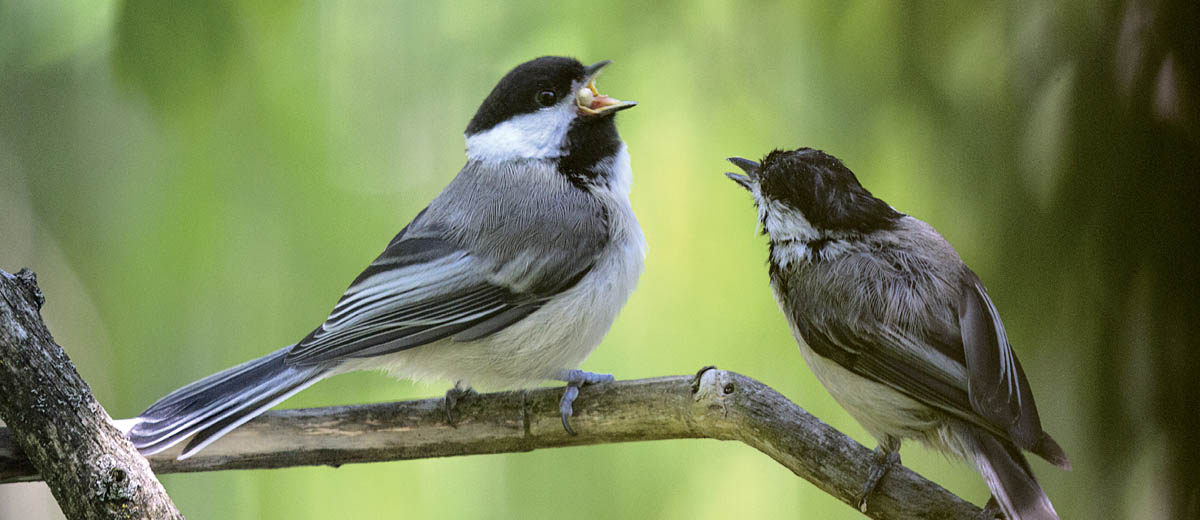
Chickadee fledglings persistently beg for food even as they start catching insects and spiders on their own. Fledglings have perfect plumage and yellow mouth linings, while adults, like the one on the right, look bedraggled after focusing entirely on family obligations for so many weeks. After the chicks depart, adults molt into fine new feathers that will carry them through the coming winter.
Frequent and popular visitors at many bird feeding stations, nuthatches seem to spend their lives topsy-turvy, facing down rather than up as they wind about tree trunks, peeking into bark crevices from a different angle and perspective than other birds. Although they often associate in loose feeding flocks with other birds, they seem to maintain personal space, giving them a standoffish demeanor.
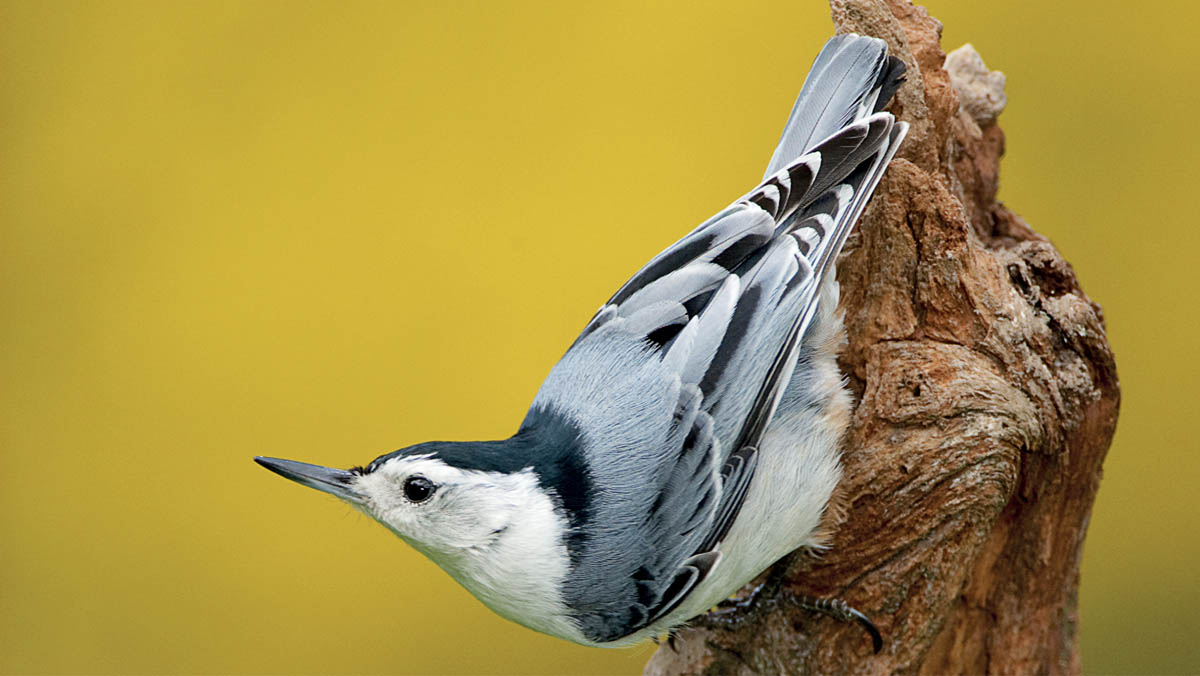
White-breasted Nuthatch male
Found across most of the Lower 48 and southernmost Canada, the White-breasted Nuthatch is a non-migratory species preferring deciduous forests. The Red-breasted Nuthatch, about half the weight of the white-breasted, is far hardier and associates with fir and spruce trees. Its breeding range extends north into Alaska and most of Canada, south below the northernmost tier of U.S. states only in mountains and in coniferous forests along the West Coast. It wanders irregularly in winter.
In winter, both species associate with chickadees, titmice, and other birds in feeding flocks. Both find small insect larvae and pupae in tree bark, and in winter both feed primarily on seeds. Red-breasted Nuthatches specialize on small conifer seeds, and the larger White-breasted Nuthatches on acorns, beechnuts, and other mast. Both come to feeders for sunflower seed, suet, peanuts, and peanut butter.
Established pairs of White-breasted Nuthatches remain on their territory year-round. Unmated males spend a lot of time in winter singing to attract a female onto their territory. When a female approaches, the male continues to sing and to display the plumage on the back of his head — the darker the nape feathers, the more attractive he appears. If she stays near, their courting behaviors may advance to exchanging hit-tuck notes and courtship feeding.
The Red-breasted Nuthatch’s wandering ways make attracting a mate trickier. In years when a pair doesn’t migrate, they may remain on their breeding territory all winter, ready for the next breeding season. New pairs seem to form after birds return to the breeding territory. A male starts by singing the courtship song, swaying and presenting his back to the female, perhaps to show her how dark his head feathers are. If she accepts him, they engage in courtship flights and feeding before they mate.
White-breasted Nuthatches nest in natural cavities, old woodpecker holes, and nest boxes. They sometimes enlarge the entrance hole but seldom excavate their own. Both sexes bring material, but the female constructs the nest, covering the floor of the hole with bark flakes and lumps of earth, then shaping a nest cup of grasses, rootlets, and bark shreds, and finally adding a lining of fur, wool, hair, and feathers. One lined her nest with wadding from an old, discarded mattress.
Red-breasted Nuthatches usually start excavating their own nest cavity as a pair, and then the female hollows out the inside chamber while the male brings her food. Unmated males may begin excavating one or more entrance holes and singing near them in an attempt to attract a mate. Although associated with conifers, Red-breasted Nuthatches seem to prefer aspens for nesting, probably because the soft wood is easy to dig into. They toss sawdust and woodchips out of the entrance hole, letting them accumulate at the base of the tree. Excavation takes up to 18 days. The female uses various fibers to construct the nest and lines it with fur, feathers, and other soft materials.
Incubation lasts about 13 days for both species. The female keeps the eggs toasty; her mate provides some of her food. During cold weather, he brings food most frequently, allowing her to remain on the eggs for longer periods; in hot weather, she can spend more time off the eggs, finding her own food.
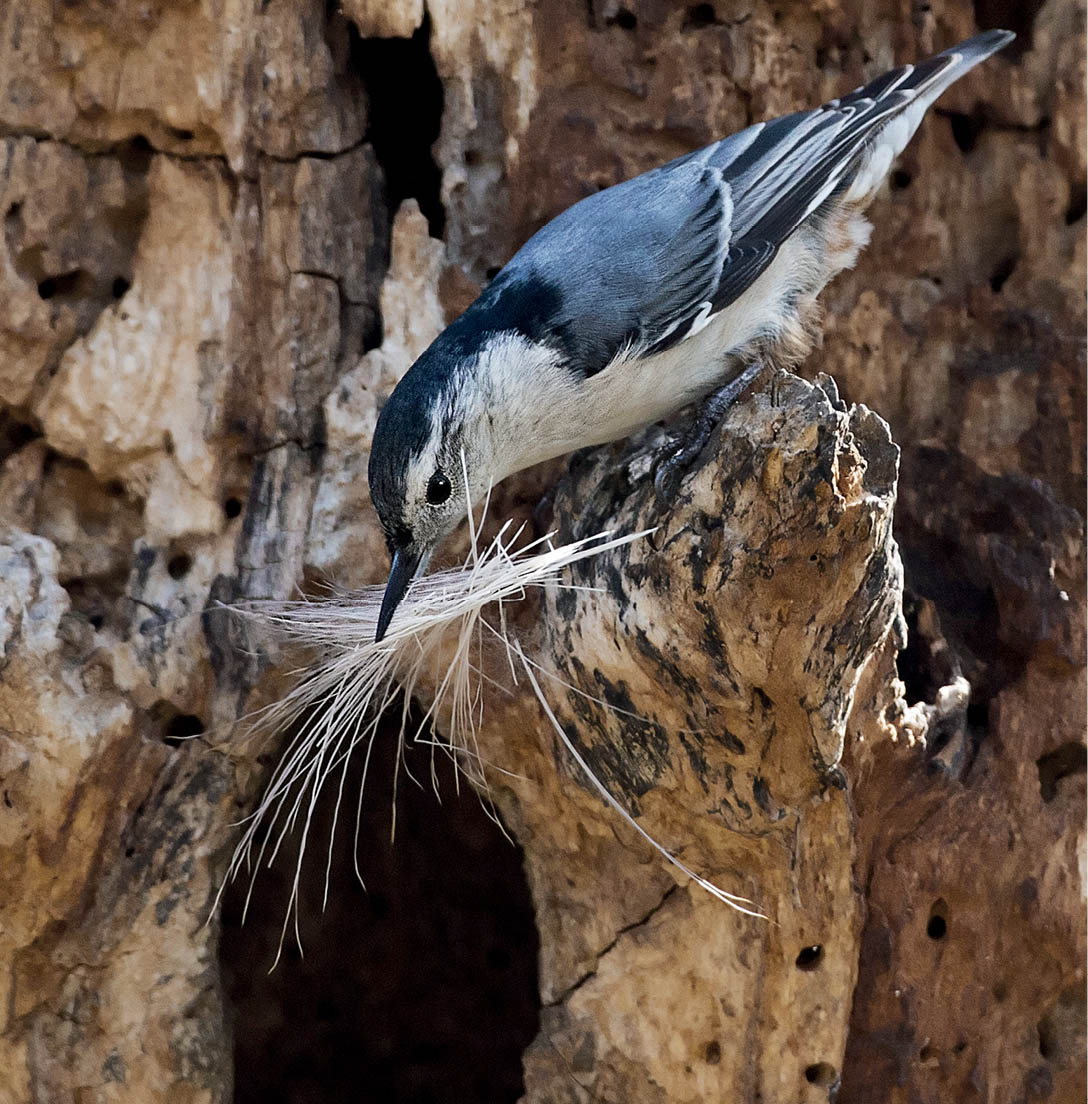
A male White-breasted Nuthatch brings a beakful of white deer fur to a tree cavity. This species builds nests in old woodpecker holes or other natural tree cavities, rock crevices, and occasionally nest boxes. It does not excavate, but may enlarge an existing hole, and often reuses nest holes year after year, each time making a new cup nest inside.
Both nuthatches have their own special ways of deterring predators from their nests. Red-breasted Nuthatches paint the entrance hole, in and out, with sticky resin from various conifers, probably to deter predators and nest competitors. Both adults carry globules of resin in their beaks or on bark scraps and use pieces of bark to apply it, the only known use of tools for this species. Males work the resin around the outside of the cavity entrance; females focus on the inner walls of the entrance, especially when they start incubating.
They continue applying resin five to ten times per day during incubation and brooding. They’re adept at diving into the nest at high speeds to avoid getting the sticky substance on their feathers, although a female was once found dead, stuck to the resin at her nest.
White-breasted Nuthatches also use their bill to smear a substance on their nest cavity to ward off predators, but in their case they choose a crushed beetle, stink bug, caterpillar, or other insect that gives off a bad smell or noxious defense chemicals. They may also add strong-smelling material to the nest — one nest lining contained cigarette butts. If the nest is threatened directly, White-breasted Nuthatches perform distraction displays, swaying with outspread wings; this may startle a squirrel or other potential predator.
Both parents feed the young. Only the female White-breasted Nuthatch broods the nestlings, but a male Red-breasted Nut-hatch may occasionally share incubation duties with his mate, and may roost in the nest cavity overnight. In both species, both parents feed the young insects, and both parents fly away with fecal sacs, dropping them at some distance from the nest. The nestlings seem to develop as typical songbirds do.
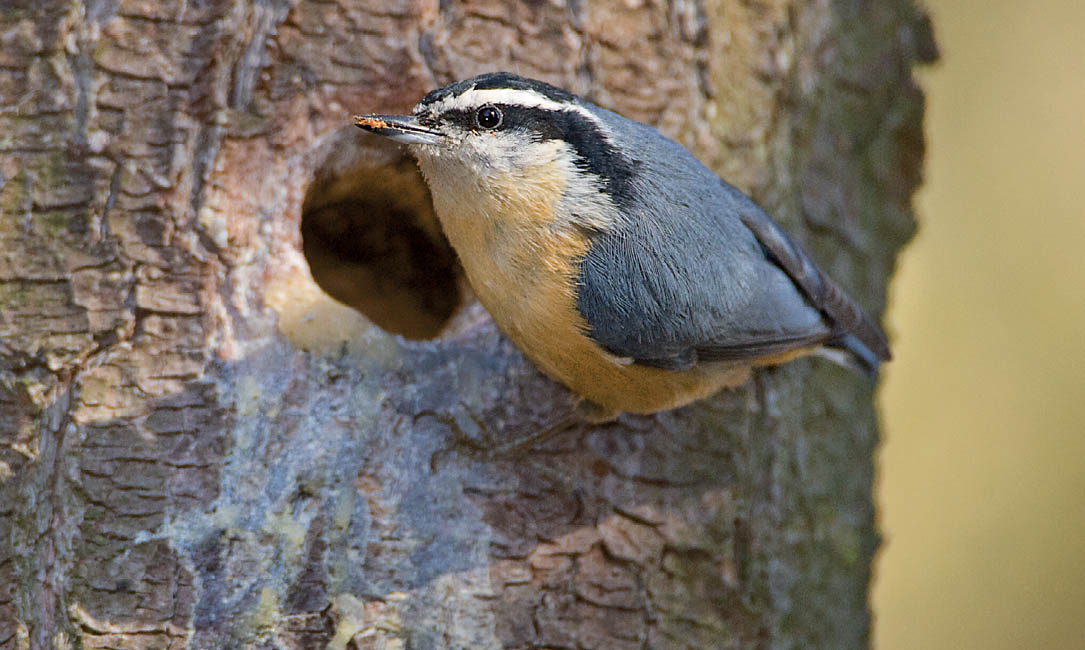
A male Red-breasted Nuthatch removes bits of wood from a cavity he is excavating. The resin below the lip of the nest hole may have flowed naturally from this pine tree, or the nuthatches may have applied it themselves.
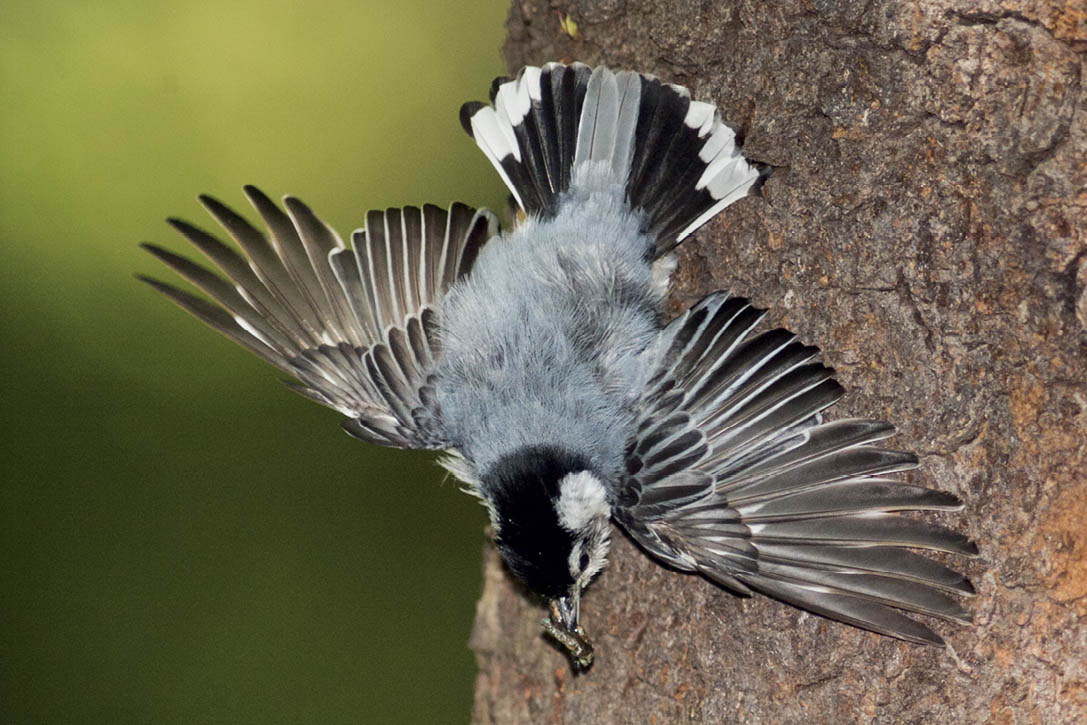
This male White-breasted Nuthatch performs a distraction display, spreading his wings and swaying. Either male or female may do this to startle and distract an approaching predator, such as a chipmunk or squirrel.
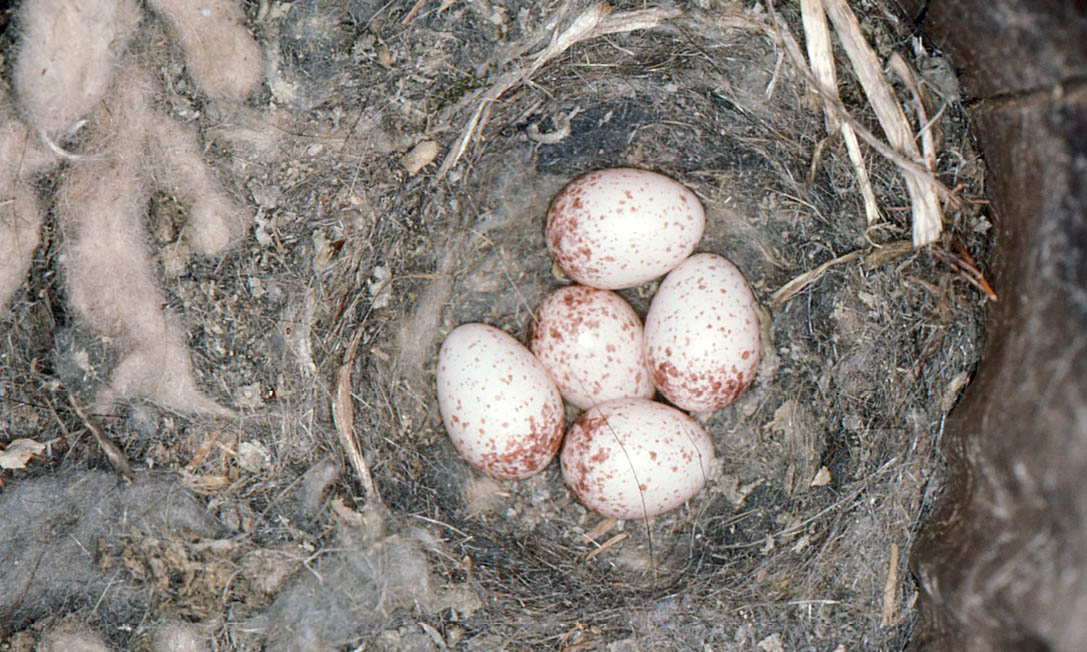
Five White-breasted Nuthatch eggs lie in their well-insulated nest of grasses, shredded bark, and pine needles, lined with animal hair and strands of wool.
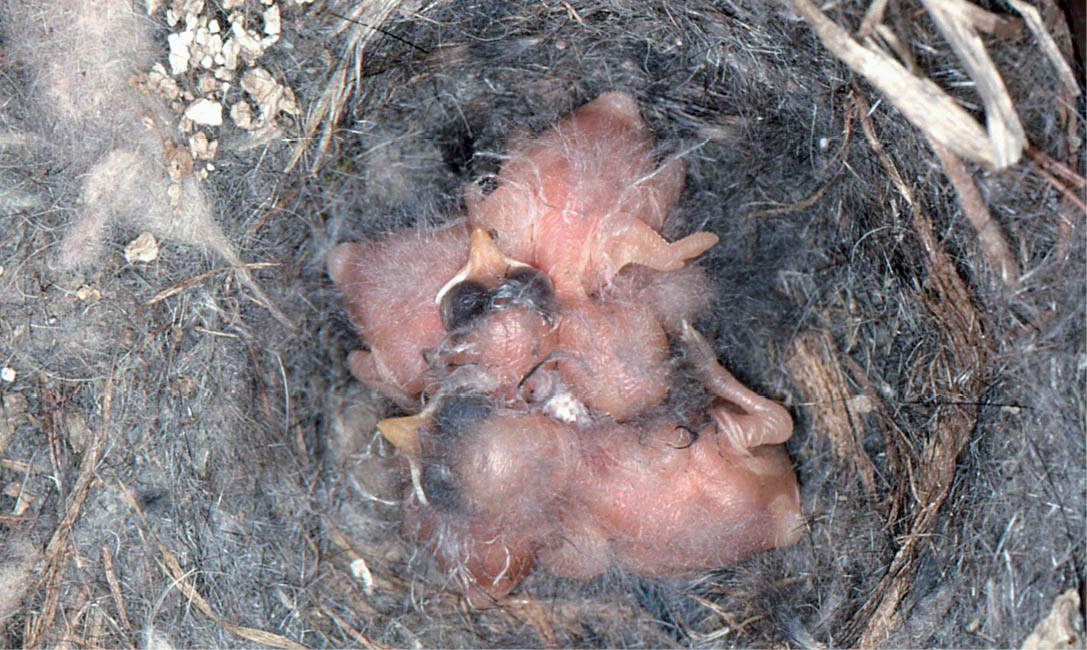
Four newly hatched White-breasted Nuthatch nestlings huddle in their nest, awaiting a parent’s food delivery. Very little research has been published about nestlings of this species, because they only occasionally use nest boxes and their natural cavity nests are hard to access.
Red-breasted Nuthatches first leave the nest between 18 and 21 days after hatching; it takes the larger White-breasted Nuthatches about 26 days to fledge. Fledglings of both species associate with their parents for at least two weeks, possibly longer.
Because so few nuthatches are banded as nestlings and tracked as individuals, it’s not known for certain whether they remain together in family units over winter, as some titmice do, or whether the young disperse, as some chickadees do. With increasing use of nest cams, some nuthatch mysteries may soon be solved, but these easily observed backyard birds may keep some of their secrets from us for many years to come.